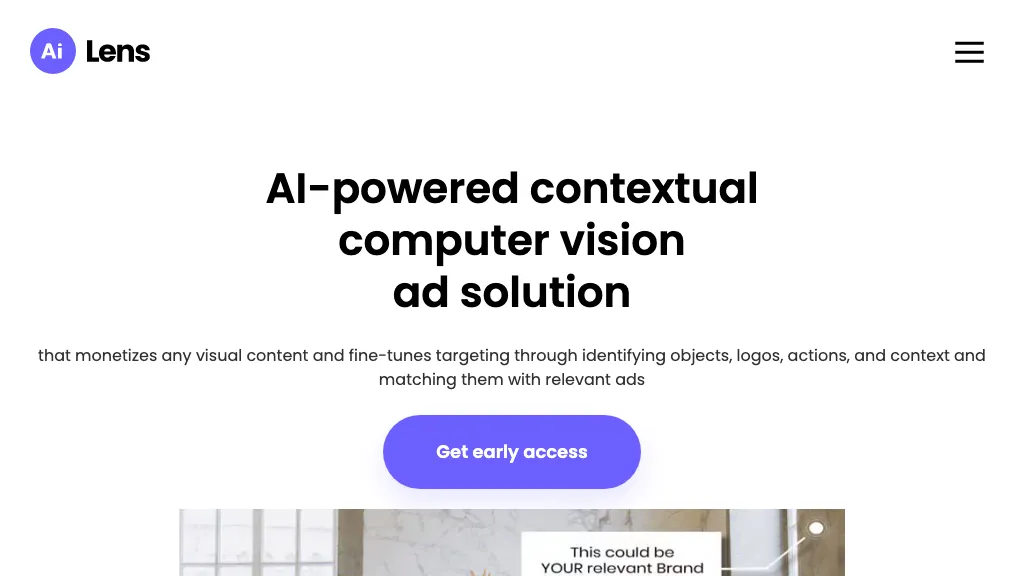What is LensAi?
LensAi is a brand new, innovative AI contextual advertising platform for publishers to help monetize web traffic. By the use of sophisticated algorithms in detecting relevant objects, logos, actions, and contexts, it will fine-tune targeting to match with relevant ads. This new platform opens up innovative in-image and in-video advertising formats, building out the digital advertising ecosystem to deliver higher ROI for brands. It uses special ad algorithms that emotionally excite users and instill a sense of urgency in buying the products. Rather than basing their traditional methods on user identity or behavior, the basis of LensAi rests on focusing on content interests when marketing to target audiences.
LensAi’s Key Features & Benefits
Contextual Advertising: Advertise in context, and not dependent on user data.
Computer Vision: The feature of computer vision is closely related to the identification of relevant objects and contexts within images and videos.
Targeting Attuning: It refines ad targeting, rendering it more relevant and effective.
In-image and in-video Advertising: It seamlessly integrates ads within the picture or video.
Emotional Engagement: Ads will emotionally engage users, raising a sense of urgency to complete the purchase.
By harnessing these features, LensAi guarantees a few advantages: better ad relevance, higher ROI for advertisers, and higher user engagement. Its value proposition is based on the monetizing of web traffic focused on the interests in content rather than on user behavior.
Use Cases and Applications of LensAi
LensAi plays multiple roles in various applications with regard to attaining different goals:
- Monetize Web Traffic: This will help the publisher generate money by yielding the best ad placement in the content.
- Increased ROI for Brands: Make advertising campaigns more effective to result in a higher return on investment.
- Target Audiences Based on Content Interests: Target based on interests reflected in content, rather than in personal user data.
LensAi serves industries such as publishing, digital marketing, and advertising. For instance, a digital marketer may use LensAi to place appropriate ads in video content while the publisher will raise ad revenue by ensuring that ads are contextually relevant to their audience. Advertisers benefit too in getting to more precise targeting, hence really maximizing their marketing efforts.
How to Use LensAi
Using LensAi involves a few simple steps to ensure one gets the best results:
- Sign Up: Create your account on the LensAi platform.
- Integrate: Add the LensAi SDK into your website or application.
- Configure: Setup your targeting preferences, along with ad placements.
- Monitor: Track the performance from the analytics dashboard and adjust whenever needed.
This means going back to regularly review the analytics to improve targeting further and testing ad formats to find what will work best with your audience. The user interface is intuitive; there’s a clear navigation menu that allows easy management of campaigns and insights.
How LensAi Works
Advanced computer vision and machine learning algorithms underpin how LensAi works. In turn, both of these technologies analyze and interpret the visual content, detecting relevant objects and their contexts, matching them to the right ad. The chain of work is as follows:
- Content Analysis: Scanning of images and videos for the detection of key elements;
- Contextual Matching: It will then match those elements with relevant ads based on that context.
- Ad Placement: The ads are seamlessly integrated within the visual content.
- Performance Tracking: Through the platform, performance of ads is tracked, and insights to optimize it are provided.
It ensures not only relevance in advertisements but also makes them engaging, which increases user interaction and conversion rates.
LensAi Pros and Cons
Like any other platform, LensAi too has its pros and cons:
Pros
- Highly Relevant Ads: Contextual advertising ensures relevance in ads to the content.
- Increased ROI: Due to better targeting of ads, the returns become higher.
- User Activity: The more emotive an ad is, the better it will drive action.
Cons
- Reliance on Visual Content: It works best for platforms that have visual-rich media.
- Setup: The setup entails integration and configuration and may be over the head of a less-than-tech-savvy individual.
Feedback from users generally shows that the platform does a great job in improving ad relevance and user interaction. However, some users of relatively limited technical expertise find the initial setup a bit complicated.
Conclusion about LensAi
Generally, LensAi is a contextual advertising powerful tool with a number of handy features that boost ad relevance and engagement. Due to its focus on content interests and not on user behavior, it definitely will be the unique and efficient solution both for publishers and advertisers. Of course, it may take some effort at the initial setup, but the potential benefit in terms of increased ROI and user engagement is rather big. And this is likely to continue with future updates and developments, making it an ever-stronger platform.
LensAi FAQs
What is LensAi?
LensAi is an AI contextual advertising platform created for publishers looking to monetize web traffic through high-end in-image and in-video advertising solutions.
How does LensAi improve ad relevance?
Video and image content is analyzed with computer vision to match the ads contextually. In fact, every digital publisher, marketer, or advertiser looking to improve ad targeting and increase returns on investment can use LensAi.
Is it hard to implement?
While some technical knowledge may be needed to integrate and configure it in the beginning, an intuitive user interface forms part of this platform to help one do so.
For which industries is LensAi best utilized?
The capabilities of LensAi serve various industries best, including publishing, digital marketing, and advertising.










